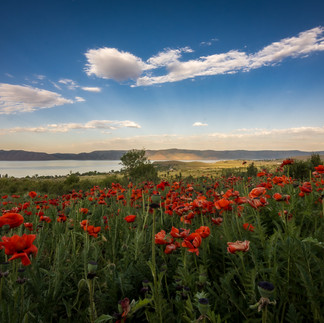Exploring Wildflowers and Captivating Skies in Nature Photography
- Austin B. Luckett
- Jun 25
- 4 min read
Nature photography offers a refreshing escape from our daily lives, inviting us to capture breathtaking moments that transport us to tranquil landscapes. Among the delightful subjects photographers can explore, wildflowers paired with the vast skies above create stunning combinations for captivating photographs. Learning how to effectively photograph these delicate flowers against dramatic skies can turn a simple nature image into a striking piece of art.
Capturing wildflowers allows us to appreciate the diversity of nature. With their vibrant colors, intricate details, and vast varieties, wildflowers showcase nature’s creativity. Pairing these floral beauties with intriguing cloud formations or vibrant skies brings them to life in photographs, making them even more engaging.
Finding Your Subject
Before diving into photography, identifying the wildflowers you want to capture is crucial. Researching local flora can yield rich rewards, as different species bloom at various times throughout the year. For instance, the striking California poppy blooms in early spring, while the delicate bluebell flowers are best photographed in late spring. Understanding these seasonal patterns provides an excellent foundation for thoughtful photography.
During your nature excursions, look for unique locations where wildflowers grow abundantly. Open fields, meadows, and even roadside patches can serve as ideal photography spots. As you venture into these spaces, ensure that you respect local guidelines for protecting natural habitats. For example, stepping off marked paths can damage delicate ecosystems, so always tread lightly.
Timing is Everything
Timing is key when photographing wildflowers. The golden hours—shortly after sunrise and before sunset—are often the best times to capture flowers in their full glory. Photographers can see up to a 30% increase in color vibrancy during these times, thanks to the soft, warm light that adds a magical quality to the images.
Weather also plays a critical role. Dramatic skies, whether filled with puffy clouds or a clear blue expanse, can elevate the entire composition. A clear sky provides a vibrant backdrop, while clouds add depth and intrigue. Understanding how different lighting and weather conditions work together helps you capture unique and memorable photographs.
Composition Techniques
Composition is vital in photography, especially when merging wildflowers with the skies. Using the rule of thirds can create balanced images; position the horizon a third from the top or bottom for a harmonious relationship between the flowers and the sky.
Another effective technique is utilizing leading lines. Natural elements such as paths, fences, or even the edges of flowering patches can guide the viewer’s eye to the main subject, giving your photograph more depth.
Don’t hesitate to experiment with angles. A low perspective can make flowers appear more prominent against the sky, while a higher angle may capture the entirety of the surrounding landscape. Testing various viewpoints helps discover the best angle for showcasing both wildflowers and skies.
Close-ups versus Wider Shots
The choice between close-up shots or wide-angle landscape images greatly affects how your story unfolds. Close-ups highlight the intricate details of petals and leaves, showcasing the beauty of individual flowers. Using a macro lens can capture textures like the delicate veins on a petal, offering an intimate view that often goes unnoticed.
On the flip side, wide-angle shots frame a broader scene, illustrating how wildflowers coexist with the sky and the surrounding environment. These expansive images convey a sense of place, allowing viewers to appreciate the entire ecosystem. For example, photographing a field of colorful daisies against an expansive sunset sky effectively captures the richness of the landscape.
Utilizing Clouds Creatively
Clouds can be more than just a backdrop; they can define your photograph’s mood. Different cloud types can evoke various feelings—wispy clouds might create a sense of calmness, while thick gray clouds can add drama. For example, photos taken before a storm often carry a brooding atmosphere that heightens the viewer’s emotional response.
Play with different exposures; a longer exposure can capture movement within the clouds, adding an ethereal quality. In contrast, a faster shutter speed can freeze the clouds in motion, creating a striking contrast with the colorful wildflowers below. Make sure to experiment to find the right balance for your artistic intentions.
Post-Processing Techniques
After capturing your images, post-processing can further enhance them. Basic adjustments—like clarity, contrast, and saturation—bring out the vivid colors of the flowers while emphasizing the intricacy of the skies. For example, a slight saturation increase of about 10% can make colors pop without feeling artificial.
Consider using software to subtly adjust the bloom of colors, ensuring the final image feels organic. Striking a balance between enhancement and realism makes your photographs more appealing while preserving the essence of nature.
Maintaining Respect for Nature
As you pursue photography, maintaining respect for the environment is vital. Avoid trampling over wildflower patches, as this can damage ecosystems. Educate yourself about local flora and their habitats. For instance, understanding that certain wildflowers may be endangered can guide your actions in the field.
Adopting ethical practices not only protects nature but also enhances the experience for future visitors and photographers. The goal should be to appreciate and showcase the wonders of nature without causing harm.
Capturing the Beauty of Nature
Photographing wildflowers against captivating skies opens a world of creativity and storytelling in nature photography. By understanding the intricacies of your subjects and utilizing thoughtful composition techniques, anyone can produce stunning photographs. Embrace the magic of diverse lighting conditions and let the clouds inspire your creativity.
With patience and practice, your photos can reflect the vibrant textures and colors of wildflowers alongside the expansive skies. By respecting nature and honing your skills, you will capture not only timeless images but also forge a deeper connection with the beautiful world around you.
Happy shooting, and may your photography journey be filled with blooming wildflowers and breathtaking skies.





















Comments